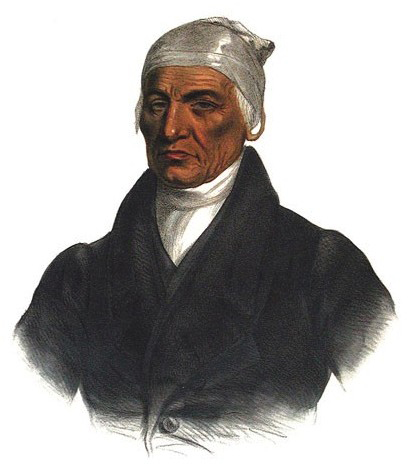Pittsburgh, PA Lewis prepares for departure down the Ohio River. Here, a fellow traveler describes the area’s safety from Indian attacks and Shawnee Chief Black Hoof’s life is briefly examined.
Ca-Ta-He-Cas-Sa [Catecahassa]
Black Hoof
Principal Chief of the Shawannes
by King, Charles Bird (1785–1862)
University of Washington Libraries, digitalcollections.lib.washington.edu/digital/collection/mckenneyhall/id/272.[1]Originally from Thomas McKenney and James Hall, History of the Indian Tribes of North America, with Biographical Sketches and Anecdotes of the Principal Chiefs. Embellished with One Hundred and … Continue reading
Original Inhabitants
Pittsburgh has been long considered by the Americans as the key to the western country. Thence the federal forces were marched against the Indians who opposed the former settlement of the Americans in Kentucky, and on the banks of the Ohio. However, now the Indian nations are repulsed to a considerable distance, and reduced to the impossibility of hurting the most remote settlers in the interior of the states; besides, the western country has acquired a great mass of population, insomuch that there is nothing now at Pittsburgh but a feeble garrison, barracked in a fort belonging to the town, on the banks of the river Allighany.
—François André Michaux[2]François André Michaux, Travels to the West of the Alleghany Mountains (1805 reprint from London edition), p. 59–60 in Reuben G. Thwaites, Travels West of the Alleghanies (Cleveland: The Arthur … Continue reading
Catecahassa, Black Hoof
Catecahassa, also known as Black Hoof and Cutthewekasaw (unknown–1831) was a Shawnee Chief and warrior involved with many key events in Ohio River Valley history. He fought against the Virginians in the 1774 battle of Point Pleasant and defended Shawnee homelands against the United States until his surrender to Anthony Wayne after the battle of Fallen Timbers in 1795. He signed the Treaty of Greenville and advocated accommodating white settlement and culture. He refused to join with Tecumseh and his brother Tenskwatawa, the Shawnee Prophet, and influenced many Shawnees to do the same. In this way, he acted as an American ally. During the Indian Removal years, he refused to sign any removal treaty or leave. After his death, his people were removed to the Indian Territory in present-day Oklahoma.
As a member of an 1802 Delaware and Shawnee delegation, Black Foot delivered a speech to President Thomas Jefferson—he later learned to speak English was considered an eloquent speaker. As recorded by a clerk, part of his speech was to ask for better living conditions for his people:
Brother
Our first request to you is that you will give us a good piece of land, where we may raise good Grain and cut Hay for our Cattle the place which will suit our nation is on the head of the Mad-River, joining our great friend Isaac Zean, down the river, eight miles & then across—streight to Stoney-Creek, or Big-Miamis down to the dividing line as drawn to Lorimein—the back line is from the said place down to a Creek of the name of Blanchard’s Creek, and down to the grand Glaize or Fort Defiance and from thense to Fort Wayne and streight to the Wabash-river runing into the Ohio, excepting what belongs to our Brothers according to the Treaty of Greenville. It is our desire to live like good Brothers & good neighbors, as long as the Grass grows, & the water runs in the rivers.
Brother,
The second request we make is that you will stop your people from killing our Game, at present they kill more than we do they would be angry if we were to kill a Cow or a Hog of theirs, the little game that remains is very dear to us—
Brother,
We hope every request will be granted and we beg your assistance in geting all necessary Farming tools & those for building houses that we may go to work as quick as possible, it is the wish of all our Brothers and likewise to furnish us with some domestick Animals—[3]“I. Address of Black Hoof, [5 February 1802],” Founders Online, National Archives, founders.archives.gov/documents/Jefferson/01-36-02-0331-0002. [Original source: The Papers of Thomas … Continue reading
Interestingly, Black Hoof addresses the President as “Brother” and uses the word 29 times in his speech. At that time and during the Lewis and Clark Expedition, Jefferson addressed Indian delegates as “children” and he himself was framed as the ‘Great Father’ by western officials including Lewis and Clark.
Notes
| ↑1 | Originally from Thomas McKenney and James Hall, History of the Indian Tribes of North America, with Biographical Sketches and Anecdotes of the Principal Chiefs. Embellished with One Hundred and Twenty Portraits, (Philadelphia: Daniel Rice and James G. Clark, 1842), vol. 1. |
|---|---|
| ↑2 | François André Michaux, Travels to the West of the Alleghany Mountains (1805 reprint from London edition), p. 59–60 in Reuben G. Thwaites, Travels West of the Alleghanies (Cleveland: The Arthur H. Clark Co., 1904), p. 157. |
| ↑3 | “I. Address of Black Hoof, [5 February 1802],” Founders Online, National Archives, founders.archives.gov/documents/Jefferson/01-36-02-0331-0002. [Original source: The Papers of Thomas Jefferson, vol. 36, 1 December 1801–3 March 1802, ed. Barbara B. Oberg (Princeton: Princeton University Press, 2009), 517–522 including notes.] |

